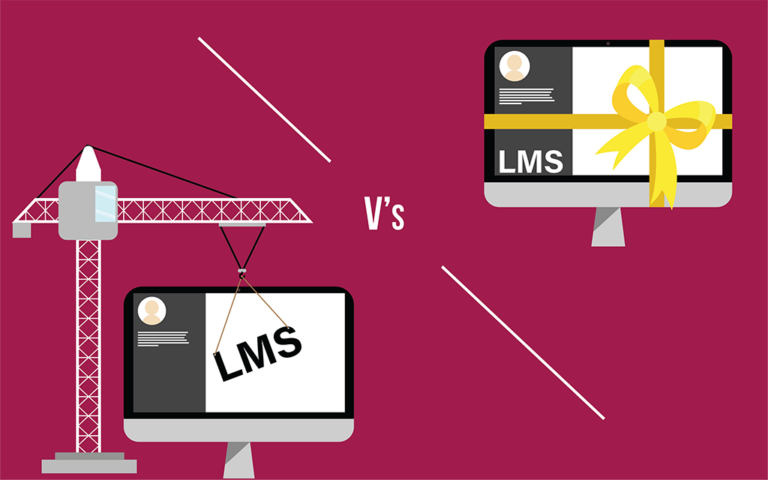Learning Management Systems – Build Vs. Buy Guide

Learning Management Systems, or LMS for short, are used to automate the induction, training and onboarding process of new and existing employees for large or rapidly growing companies and for businesses with employees dispersed over multiple branches or locations.
They are also used by companies with limited scope or budget to increase the size of their HR departments but have a constant need to hire and train new and existing staff. You may have never heard of an LMS before because you’ve never had these types of challenges… until now.
In your search for a solution, one of the things you should discover is the different types of platforms that exist for example cloud-based SaaS systems and open-source on-premise systems.
You will need to analyse the detail of both these systems and consider which one is right for your business. Do you want to self-build a learning management system and host it on-premise or use a cloud-based solution provided and managed by a system vendor?
There are many reasons why your business might choose one type of LMS over another. For example, a self-built LMS needs developing, server hosting, system support etc. and you may have the IT resources in-house to maintain the LMS. While on the other hand, without in-house IT expertise you can choose software as a service LMS that is already tried and tested, that is cloud-hosted and is fully managed by your system vendor, taking all of the hassles and added costs out of the equation.
In this post, we will put these two types of LMS head-to-head and try to shine a light on the pros and cons of each type of system installation in a showroom style build versus buy scenario.
What’s the overall cost difference in LMS deployment?
Build – Any solution you choose to build yourself is going to be pricey upfront. On-premise learning management systems generally mean huge costs. They bring added hardware infrastructure and IT support costs which are not necessarily associated with cloud-based LMS systems.
Buy – There is generally a very little cost associated with deploying a cloud-based LMS when compared to a self-hosted solution. Cloud-based systems are usually charged at a nominal fee per user licence annually and the vendor may charge an initial services fee to manage the implementation phase needed to get the system ready for go-live. After deployment, the system will be already configured and easy for an administrator to maintain. They will always have 24/7 support available for training and if problems arise.
How soon can the LMS be implemented and go-live?
Build – If you’re not looking for an immediate solution then building an LMS can be a viable option for you. Just be sure to remember that building an LMS may take up to a year or more. It also takes time to bed in a newly built system from scratch.
Buy – Selecting a cloud-based off-the-shelf solution that can be configured and implemented quickly will save you months or even years compared to a self-build project. Getting your LMS to deployed quickly means your business can rapidly test the eLearning content, training model, and user experience in a more agile way.
How hard is it to maintain the different types of LMS?
Build – As mentioned in our opening, a self-build LMS will need dedicated IT resources to design the system, oversee the development, the hosting, the implementation phase and the ongoing support if you want to host the LMS on-premise. They will also be responsible for security, user and account management, data migration from the legacy system if applicable, system integration with your HR system if required, and perhaps integration with other systems such as online portals, eCommerce software, accounting packages, web-conferencing, ERP etc.
Buy – An off the shelf cloud-based learning management system is managed and hosted by the system provider for a fraction of the cost of a dedicated IT resource. The vendor can also provide regular system updates and will make any changes requested by the client. They will also manage the implementation phase and import any data that you require.
How easy is it to make bespoke changes to the LMS?
Build – Self-hosted systems will not only need an IT resource but someone with a developer level of skills to scope out and build the missing functionality that you require into the system. If you don’t have a developer in-house it can become much more expensive as freelance developers charge huge fees per day.
Buy – A cloud-based, vendor-owned system can be easily changed on request as and when your business requires it. With direct support, the system can be tweaked to suit your unique business training needs. These type of systems are normally fully tailored to suit your business needs during the implementation phase before the go-live date.
How often does the LMS receive updates?
Build – Self-build and hosted systems can only be updated when you or your administrator decide that it’s time to update them. It’s a manual process that would need to be done regularly in order to maintain system integrity.
Buy – SaaS systems are updated automatically free of charge. The system developers are constantly listening to customer feedback, implementing change requests and improvements are happening all the time. These changes are rolled out to new and existing customers quarterly. Most of these SaaS systems will have a product roadmap that is always extending in order to keep up with developing technologies.
Is the end-user experience different?
Build – Self-build and hosted LMS systems are usually based on free open-source software like the academic platform Moodle which is not designed for a business environment. The software is built by open source communities and generally consists of code comprised of a whole host of different authors which leads to challenges with maintaining or modifying the look and feel of the system. Even the most gifted IT architect will struggle to make the LMS feel simple and user-friendly.
Buy – Cloud-based corporate learning management systems are specifically designed for the workplace. They are easy to use and the main focus is on allowing the user to perform the task required as fast and efficiently as possible. The UI is usually minimalistic and without clutter. The systems are flexible and over time, improvements can be made to improve the learner experience.
LMS – Head-to-Head Comparison
Cloud-based LMS
- No installation required
- Deployment time 2/3 weeks
- Costs are pre-set based on clients’ needs
- Hosted on the provider’s server
- Data security maintenance is done by the SaaS provider
- Version updates will include new functionality
- Software updates are automatic and free of cost
- Client support is available 24/7 by experts
Open Source or On-Premise LMS
- Requires installation and set up
- Deployment time in excess of 12 months
- Ownership costs may increase based on usage
- Installed on the company server
- Data security must be maintained by the user
- Additional functionality is often only available through plugins
- Updates need to be done manually
- Support is available through forums and user communities
Conclusion
When researching learning management systems it’s important to demo the ones that you think match your requirements to get a feel for them. Deciding on which type of deployment is right for you will really depend on the size of your company and its resources.
If you have an internal IT department or access to developers then an open-source or Moodle based system can provide a good solution but it has its challenges. Some of these systems can be a little flat or user-unfriendly but that does not impact their ability to deliver the functionality that you need.
With a SaaS-based LMS on the other hand, all hardware, software and security concerns are handled by the LMS provider. Updates and patches are delivered regularly by the provider free of charge as part of the regular licence fee. SaaS-type LMS solutions tend to be more polished and user-friendly with a focus on the business environment where efficiency is a higher priority than in an academic environment.
If you want the fastest possible implementation at the lowest possible cost then choose a cloud-based LMS provider and avoid an on-premise self-build solution.

